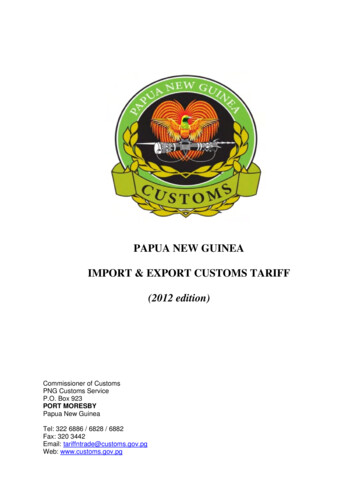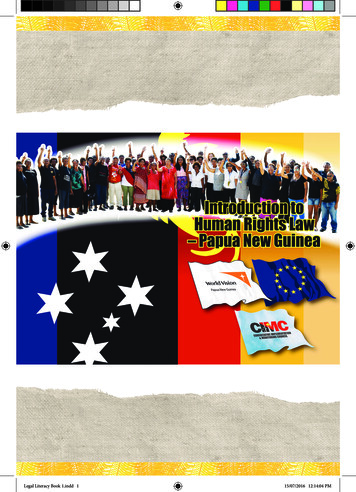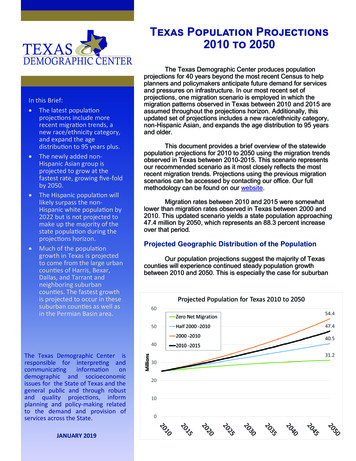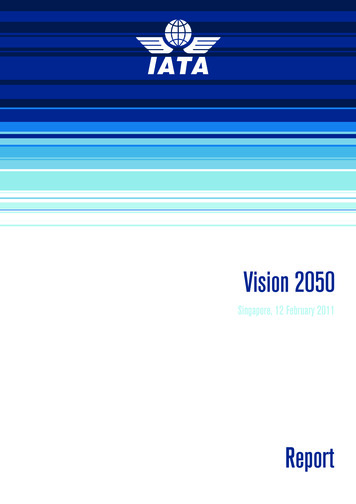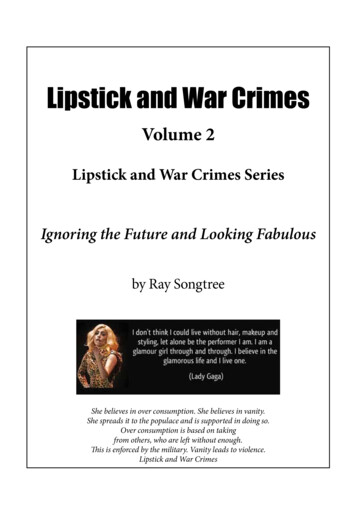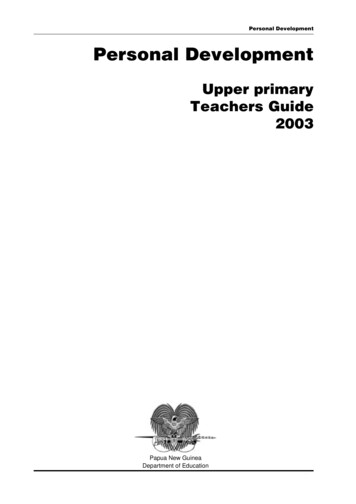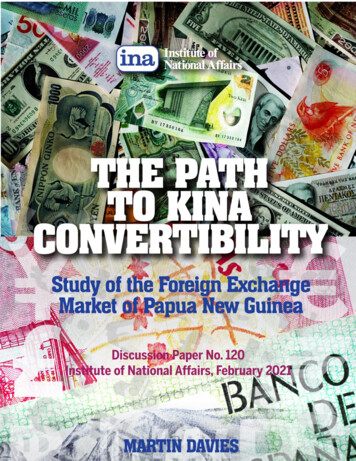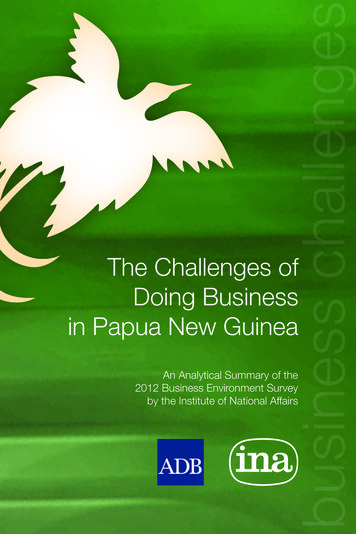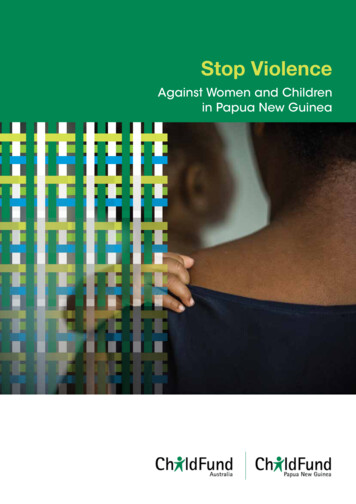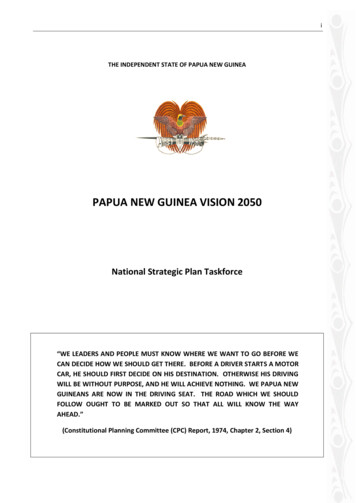
Transcription
iTHE INDEPENDENT STATE OF PAPUA NEW GUINEAPAPUA NEW GUINEA VISION 2050National Strategic Plan Taskforce“WE LEADERS AND PEOPLE MUST KNOW WHERE WE WANT TO GO BEFORE WECAN DECIDE HOW WE SHOULD GET THERE. BEFORE A DRIVER STARTS A MOTORCAR, HE SHOULD FIRST DECIDE ON HIS DESTINATION. OTHERWISE HIS DRIVINGWILL BE WITHOUT PURPOSE, AND HE WILL ACHIEVE NOTHING. WE PAPUA NEWGUINEANS ARE NOW IN THE DRIVING SEAT. THE ROAD WHICH WE SHOULDFOLLOW OUGHT TO BE MARKED OUT SO THAT ALL WILL KNOW THE WAYAHEAD.”(Constitutional Planning Committee (CPC) Report, 1974, Chapter 2, Section 4)
ii
iiCONTENTSABBREVIATIONS . vTHE NEXT GENERATION OF NATION BUILDERS . xVISION 2050: OUR PEOPLE’S VISION . xiiEXECUTIVE SUMMARY . xivDIRECTIONAL AND ENABLING STATEMENTS . 1Directional Statement . 1Pillars for the Vision . 31.17Human Development, Gender, Youth and People Empowerment . 51.18Public Investment Budget Strategy . 11Enabling Statement: Ensuring a Systemic Change . 121.19Leadership . 121.20Human Resources . 121.21Legislation . 121.22Finance . 131.23Infrastructure . 131.24Service Delivery Mechanism . 131.25Citizen Participation . 141.26Monitoring and Accountability . 14CHAPTER ONE: WHY A 40-YEAR VISION 2050? . 15Brief Facts about Papua New Guinea . 15A Brief History of Development Planning. 15Socioeconomic Development Experience . 1622.Summary . 19CHAPTER TWO: CURRENT SCENE AND FUTURE SCENARIOS . 203.Summary . 29CHAPTER THREE: VISION 2050 . 304Our Vision and Mission . 305.Our Mission Statement. 3122.Summary . 54
iiiCHAPTER FOUR: INSTITUTIONAL FRAMEWORK FOR VISION 2050 . 551.Introduction. 552.National Ownership and Commitment . 553.Partnership . 554.Operational Strategy . 565.Information and Communication Strategy . 566.Monitoring Evaluation and Review . 567.Summary . 57CHAPTER FIVE: THE FUTURE . 58Introduction . 587.Summary . 59References . 60ACKNOWLEDGEMENTS . 63
ivBoxes, Figures, and TablesBox 1.1 Papua New Guinea in Brie . 15Figure 2.1 Real GDP Growth Scenarios, 2010-2020 . 27Table 2.1 Four-Pronged Projected Economic Scenario, 2010-2050 . 28Table 2.2 Strategic Target Goals for Vision, 2050 . 28Figure 3.1 The Seven Strategic Focus Areas of Vision 2050 . 27Table 3.1 Strategies for Strategic Focus Area One: Human Capital Development, Gender, Youth and PeopleEmpowerment. . 36Table 3.2 Strategies for Strategic Focus Area Two: Wealth Creation .37Table 3.3 Strategies for Strategic Focus Area Three: Institutional Development and Service Delivery 39Table 3.4 Strategies for Strategic Focus Area Four: Security and International Relations . 40Table 3.5 Strategies for Strategic Focus Area Five: Environmental Sustainability and Climate Change 42Table 3.6 Strategies for Strategic Focus Area Six: Spiritual, Cultural, and Community Development . 43Table 3.7 Strategies for Strategic Focus Area Seven: Strategic Planning, Integration, and Control . 44Figure 4.1 PNG Vision 2050 Review.48
CNPEPNRINSANSOOBEOECDOFDEOLIPPACOLPGLLGAsia Pacific Economic CooperationAssociation of South-East Asian NationsBalance of PaymentBank of Papua New GuineaCentral Agencies Coordinating CommitteeConstitutional Planning CommitteeCentral Planning OfficeDistrict Services Improvement ProgramDistrict Transport Improvement ProgramEducation Endowment FundExclusive Economic ZoneGross Domestic IncomeGross Domestic ProductGross Enrolment RateGovernment of Papua New GuineaHuman CapitalHuman Development IndexHuman Infected Virus/ Acquired Immune Deficiency SyndromeHealth Sector Improvement ProgramInformation Communication TechnologyInternational Monetary FundIndustrial Technology Development InstituteKey Result AreasLocal-level GovernmentLiquefied Natural GasLong-Term Development StrategyMillennium Development GoalsMedium Term Development StrategyNational Aids Council SecretariatNational Agriculture Development PlanNational Curriculum Assessment and Monitoring AuthorityNational Department of HealthNational Executive CouncilNational Economic and Fiscal CommissionNational Goals and Directive PrinciplesNon-Government OrganizationNational Planning CommitteeNational Public Expenditure PlanNational Research InstituteNon-State ActorNational Statistical OfficeOutcome Based EducationOrganization of Economic Cooperation and DevelopmentOpen Flexible and Distance EducationOrganic Law on the Integrity of Political Parties and CandidatesOrganic Law on Provincial Governments and Local-level Governments
ESOPSTITRPUBEUNDPProvincial and Local-level Service Monitoring AuthorityPapua New GuineaPublic Private Community PartnershipPublic Private PartnershipPublic Service Reform Management UnitResearch and DevelopmentRural Education Services ImprovementRoyal Papua New Guinea ConstabularyStructural Adjustment ProgramService Delivery Mechanism ModelStrategic Focus AreaSmall-Medium EnterpriseState-Owned EnterpriseStandard Operating ProcedureSexually Transmitted InfectionTariff Reduction ProgramUniversal Basic EducationUnited Nations Development Program
xTHE NEXT GENERATION OF NATION BUILDERSAfter three decades of political independence, my Governmenthas had the courage to step back and reflect on our journey as ayoung nation. Most importantly, we have taken critical stock ofour level of progress and have now set a new path for our futureto ensure that positive development is not left to chance. It is nosecret that a stable political environment has played a major rolein enabling Papua New Guinea to chart this bold course, whichwas not possible in the past.In December 2008, my government tasked the National PlanningCommittee with the responsibility of setting a visionarydevelopment strategy to guide our socioeconomic development.It gives me the greatest pleasure and a sense of distinct duty topresent to you the Papua New Guinea Vision 2050. Our Vision2050 provides every man, woman, boy, and girl in this nation with the opportunity for personaldevelopment and positive engagement. As a government, we are convinced that we must empower ourpeople with the right education and life-skills, and provide them with the opportunity to earn an honestliving. Only then can we guarantee our nation’s continued prosperity and security.I want to assure our people that the Papua New Guinea Vision 2050 is a ‘home-grown’ initiative. Althoughwe have sought input from our friends in the region, the aspirations that are reflected in Vision 2050 havebeen derived from wide consultations with our people from the 89 constituencies in the country. Simplevillagers, mothers, children, qualified academics, and other professionals have contributed to thisdocument. The final version of Vision 2050 has been prepared by our own sons and daughters, with inputsfrom some of our most qualified citizens. I am personally proud of this because these people are theproducts of the past 34 years of nation building.Our journey towards the Papua New Guinea Vision 2050 has already begun. In August 2009, myGovernment reached agreement with the governors of the provinces, resulting in the ‘MorobeCommuniqué’. This agreement has now set the tone for the future of Papua New Guinea, as envisionedunder Vision 2050. We have agreed to a political structure to help us advance our shared nationalInterests. I commend the governors, Ministers of State, Members of Parliament and all other politicalleaders for their invaluable contributions to the process.Our grave concern for service delivery to our people, particularly in the rural communities, prompted us togive particular attention to institutional development and service delivery through the service deliverymechanism. It is our intention to ensure that, in the future, our service providers deliver serviceseffectively and equitably to our communities.I am particularly comforted to note that, throughout history, countries with fewer resources than us havesucceeded in building prosperous and progressive societies. Our challenge is to utilise the vast resourcesthat God has blessed us with to better the lives of our people, today and into the future, in a responsibleand fair way.
xiI have always been a strong believer in long-term planning, with my first attempt being the launch of theNational Development Strategy in October 1976. Given the personal achievements of our sons anddaughters in the public service, academia, business and other areas, I am convinced that we now have theprerequisite foundation, which did not exist in the early years after independence, to succeed in thisendeavour.We have made some bold statements in the Papua New Guinea Vision 2050 about the kind of society wewant to enjoy and leave for the future generations. It goes without saying that we aim for nothing lessthan achieving the highest quality of life for our people.I wish to pay special tribute to the churches who have played a major role in the development of ournation. Much of the burden of providing health and education to our people has been carried by theseorganisations. I now call upon them to again partner us the people, because their expertise and assistancewill be required for us to deliver the aspirations of the Papua New Guinea Vision 2050. This governmentalso recognises the need for churches to play a much larger role moulding the characters of our people toenable us to shift paradigms away from the current prevailing attitudes.In order to be successful, we must also ensure that our public servants are skilled and properly resourced inorder to deliver the promises of the Papua New Guinea Vision 2050. It is my firm belief that our publicservants hold the key to achieving the targets which we have set.We have only one strategic vision, and that is the Papua New Guinea Vision 2050. All future medium tolong-term strategies and plans must align to this vision in a cascading way, whereby there is only one highervision. Others simply take their cue from the Papua New Guinea Vision 2050’s Mission Statement.It is the sincere hope of my government that future governments will embrace the Papua New GuineaVision 2050, and that it will enjoy bipartisan support today and in the future. I trust that all successivegovernments will continue to monitor and review our performance against the targets that we have set.This remains one of the noblest tasks which we can discharge, as leaders to our people.I challenge every citizen to seize the promise of Vision 2050 and advance themselves. Through this process,I expect that you will realise your rights and privileges as citizens of this great nation and take yourappropriate place in society.God bless Papua New GuineaRt. Hon. Grand Chief Sir Michael T. Somare, GCL, GCMG, CH CF KStJPrime Minister
xiiVISION 2050: OUR PEOPLE’S VISIONIn the launching of Papua New Guinea’s first ever national vision,on behalf of the people of Papua New Guinea, I acknowledge andexpress our deepest appreciation to our founding fathers, who hadthe foresight to chart the course of our nation’s history. They werewise and able Papua New Guineans.We are indebted to so many of our late distinguished leaders likeSir John Guise, Sir Paul Lapun, Sir Paulus Arek, Sir Tei Abal, MrMathias Toliman, Sir Ebia Olewale and Sir Maori Kiki and manyothers for their wisdom and leadership.Others are still serving the nation today such as the Prime Minister,Grand Chief Rt. Hon. Sir Michael Somare, Rt. Hon. Sir Julius Chan,Sir John Kaputin, Mr. John Momis and Mr. Bernard Narokobi toname a few. These leaders had visions and courage and took thefirst steps to formalise the birth of our nation.They were the people who conceived the vision and laid its framework in the National Goals and DirectivePrinciples which are enshrined in our Constitution. I acknowledge and thank every Papua New Guinean,our friends, and our development partners who have contributed one way or another, towards thedevelopment of the Papua New Guinea Vision 2050.Thirty-four years after our independence we are now making history by using the framework that was setin our National Goals and Directive Principles to develop Vision 2050.The concepts and strategic direction in the framework of Vision 2050 were rigorously tested during athree-month comprehensive nationwide consultation program in the 89 districts and Papua New Guineanchildren, adolescents and adults were asked to contribute to the development of Vision 2050.I am pleased to say that the response was overwhelming, as men, women and children came forward anddescribed the type of Papua New Guinea in which they would like to live. On the basis of these publicconsultations, Vision 2050 was formulated. Vision 2050 is based on the dreams and aspirations of themany Papua New Guineans who yearn to live in a country where all people are given a fair go in life. Itherefore believe that Vision 2050 is truly the ‘people’s vision’.Vision 2050 sets the overall direction for the country to attain our dream to be a Smart, Wise, Fair, Healthyand Happy Society by 2050. This means that by 2050, we as a people, will reward excellence and reachhigh standards of innovativeness. We will also be healthy, wealthy and safe. Our institutions will practiseand uphold higher standards of transparency, accountability and good governance. In addition, our peopleand government will contribute more effectively to the social and economic well-being of our beautifulnation.I pay special tribute to our Grand Chief, the Rt. Hon. Sir Michael Somare and members of the NationalPlanning Committee in recognition of their leadership in this endeavour.I also thank the 12-member National Strategic Planning Taskforce and its Technical Advisory Team, fortheir valuable contributions.Furthermore, I wish to thank many of our people who have steadfastly prayed for a better Papua NewGuinea. This is a testimony of their combined loyalty to translate the thinking of the Government and theaspirations of our people into a directional statement that will guide the nation forward over the next 40years, through the Vision and Mission of The Papua New Guinea Vision 2050.
xiiiAbove all, I thank God for his inspiration in the development of this vision and pray for his continualguidance as we endeavour to take Vision 2050 forward.Hon. Sir Dr. Puka I. Temu CMG, KBE, MPDeputy Prime Minister and Chairman of the National Planning Committee
xivEXECUTIVE SUMMARYIn December 2007, the National Executive Council (NEC) of Papua New Guinea, on advice from the NationalPlanning Committee (NPC), made a decision to develop a framework for a long-term strategy — “ThePapua New Guinea Vision 2050” — that should map out the future direction for our country and reflect theaspirations of the people of Papua New Guinea.Vision 2050 is underpinned by seven Strategic Focus Areas, which are referred to as pillars: Human Capital Development, Gender, Youth and People Empowerment;Wealth Creation;Institutional Development and Service Delivery;Security and International Relations;Environmental Sustainability and Climate Change;Spiritual, Cultural and Community Development; andStrategic Planning, Integration and Control.Papua New Guinea has great potential through its natural resources — land, cash crops, forests andfisheries — to improve its socioeconomic development status. Equally important are other areas that cancontribute to economic growth and better living standards for the people, including human capitaldevelopment, an improved infrastructure networks and an efficient service delivery mechanism for publicgoods and services. These areas underscore the underlying theme that drives Vision 2050 and thedevelopment agenda for Papua New Guinea.Based on the deterioration of the provision of public goods and services and lack of meaningfulparticipation of the rural people in income-earning activities and their aspirations to do better, Vision 2050incorporates the National Government’s Strategic Directional Statements that will drive developmentinitiatives over the next 40 years.The nation will focus all its efforts and will strive to achieve the following key outcomes: Changing and rehabilitating the mind-set of our people;having strong political leadership and will power;improvement in governance;improvement in service delivery;improvement in law and order;development of strong moral obligation; andrapid growth potential which can be realized in a reasonable time.When the directional statements together with the seven pillars are effectively and efficiently implementedin programs and projects, Papua New Guinea will be transformed into an emerging developing country.To be among the top 50 countries in the United Nations Human Development Index (HDI), there will beseveral pathways which Papua New Guinea’s economy can take. Vision 2050 will pursue four developmentroutes for the first ten years. For the years 2020 through to 2050, we will aspire for economic growth atsome desirable rates, underpinned by key development projects. These include better service delivery,improved education, improved health services and sound political leadership and structures.
xvThe Base Case Scenario (Scenario One) in the economic growth projections involving renewable resourcesis the minimum possible under improved service delivery, the promotion of human capital development,increased downstream processing, development and adoption of new technologies and improvedproductivity (see Chapter 2). The economy will grow in real terms at an average of 4.5 percent per year upto 2020. With an estimated population growth of 2.5 percent over the next 40 years until 2050, an increasein per capita income is expected.When Land Reform (Scenario Two) is undertaken starting in 2010, the Base Case Scenario will be enhanced.When around three percent more of customary land is brought into production in the formal sector, theeconomy is projected to grow at an additional 1.2 percent each year on average. This scenario willempower our people to participate in income-generating activities through cultivation of their land. Thiswill lead to broad-based economic growth and ensure balanced development in rural and urban areas.With the inclusion of the Liquefied Natural Gas (LNG) project (Scenario Three), excluding land reform, theeconomic growth will be even better.When the combined three scenarios are realised (Scenario Four), real GDP growth will more than double.Papua New Guinea can become a smart, fair, wise, healthy and happy nation when all the directionalstatements under Vision 2050 are articulated, institutionalised and implemented efficiently and effectively.In summary, opportunities will be created under the combined scenarios for Papua New Guineans to takepart in the development processes: empowering the people through improved education and life-skills;working the land and benefiting from spin-offs from major projects;enhancing the level of service delivery and basic infrastructure; andincreasing trade volume.
Directional and Enabling Statements1DIRECTIONAL AND ENABLING STATEMENTSDirectional Statement1.1Serious thinking about development planning in the then Territory of Papua and NewGuinea first evolved from the recommendations of the Foot Mission from the UnitedNations in 1962. At self-government in 1973, Chief Minister Michael Somarecommissioned the development of what became known as the Eight Aims and laterrenamed the Eight Point Plan. The Eight Point Plan1 was a statement of intent by thefounding fathers of our nation who wanted to build a peaceful and harmonious society aswell as to prosper and empower our people. The objectives under the Eight Point Planare: increased indigenous participation in the economy;equality amongst ethnic groups, gender and between areas;greater attention to rural and village development; andself-reliance.1.2In 2009, thirty-four years later we still have not progressed as aspired to at independence.As a country, we have not progressed well particularly in delivering services to our ruraland remote communities. Our national history indicates that we have: lacked clear strategic actions in our development plans; experienced corruption and poor governance; fared poorly in our economic performance, particularly for the periods 1989 – 1990and 1995 – 2002; and been rated poorly in our social development performance, despite the positiveeconomic growth that was experienced during the periods 1981 – 1988, 1991 – 1994,and 2003 – 2008.1.3All of these factors point towards the critical need to chart a new development coursehence, the rationale for Vision 2050.1.4Vision 2050 is the aspiration of every Papua New Guinean to fulfil the dreams of ourfounding fathers and to ensure that the correct mechanisms are in place for our country’sfuture.1.5The challenge for Vision 2050 is to ensure that we set clear, attainable goals and secureour future well-being by building internal capabilities. Based on our nation-buildingexperience so far, critical lessons have been learned, which are now guiding thedevelopment of Vision 2050.1Somare, M, 1974
2Vision 20501.6These lessons are: 1.7Papua New Guinea needs a vision to guide medium-term development plans over alonger period;Papua New Guineans must have noble values and positive attitudes and learn tobecome powerful forces and change agents for development and nation building;Papua New Guinea must set minimum standards for its institutions and systems sothat their integrity is not compromised. Institutions and systems must be compelledand committed to deliver high quality services to all citizens at all times, particularly intough economic times;having an abundance of natural resources does not make nations socially poor orprosperous;race or skin colour does not make nations socially or economically poor or prosperous;andthe difference must be in our attitude, mind-sets, dedication and commitment topursuing sustainable socioeconomic development.After three decades of political independence, we are critically reviewing our systems,institutions and policies because our people are demanding better ways forward andbetter performance results for the future. In development thinking, two major changesare critical, if we are to deliver better quality results: Papua New Guinea must have a ‘long-term strategy’ to underpin, guide and support itscurrent medium-term development strategies; Papua New Guinea’s policies, institutions and systems must shift from the current‘scarcity mentality’ to the positive ‘abundance mentality’ to activate this paradigmshift; and Vision 2050 embraces the five National Goals and Directive Principles that areenshrined in our Constitution2, as our Guiding Principles:1.7.11.7.21.7.31.7.41.7.51.82Integral Human Development;Equality and Participation;National Sovereignty and Self-Reliance;Natural Resources, Resource Creation and Environment; andPapua New Guinean Ways.Taking into account the emerging global economic trends, Vision 2050 seeks to positionPapua New Guinea in the global environment in order to maximise its comparative andcompetitive advantages, thereby including an additional “Guiding Principle No. 6 —Papua New Guinea Is Progressive and Globally Competitive”.Papua New Guinea Constitution 1975
Directional and Enabling Statements1.93The Strategic Direction: Currently, our economy is dominated by the mining and energysectors. These sectors contribute approximately 80 percent of our total export revenue.1.9.1The strategic direction for Vision 2050 is that, “Papua New Guinea will developand grow the manufacturing, services, agriculture, forestry, fisheries and ecotourism sectors from 2010 to 2050”. This direction will enable economic growthby 2050 to be broad based, ensuring that disposable household incomes will bemuch higher than at present. These initiatives will enhance our socioeconomicperformance and improve our overall HDI ranking.1.9.2The challenge therefore is, ’How do we shift an economy that is currentlydominated by the mining and energy sectors, to one that is dominated byagriculture, forestry, fisheries, eco-tourism and manufacturing, between 2010 and2050?’Pillars for the Vision1.10 The Vision 2050 will focus on ‘Seven Pillars’ from 2010 to an Capital Development, Gender, Youth and People Empowerment;Wealth Creation;Institutional Development and Service Delivery;Security and International Relations;Environment Sustainability and Climate Change;Spiritual, Cultural and Community Development; andStrategic Planning, Integration and Control.1.11 Papua New Guinea enjoys substantia
document. The final version of Vision 2050 has been prepared by our own sons and daughters, with inputs from some of our most qualified citizens. I am personally proud of this because these people are the products of the past 34 years of nation building. Our journey towards the Papua New Guinea Vision 2050 has already begun.
